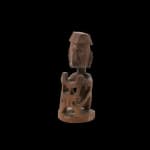A Papua wood figure of a Korwar North West Irian Jaya, Vogelkop area, coastal Geelvink Bay, present-day Cenderawasih Bay, early 20th century
Starrenburg
published a booklet about his mission on Roon and described how he got the
Korwar:
'Around the
hut, there were skulls and small ancestor sculptures (called Korwar). As the
owners wanted to become Christians, I could take everything, but I wasn't
allowed to take them away through the front door, so a hole was made in the
side of the hut. Onboard of my little boat, a storm came up and I nearly lost
everything. The Papua attributed this happening to the power of the spirts, but
I came home with everything safely anyway!'
Starrenburg
is also referred to as being on Roon around 1910 in the famous book ' Kruis en
Korwar' by Drs. F.C. Kamma.
Literature:
D.B.
Starrenburg, Kerk der Hope: bijdrage tot kennis der Nieuw-Guinea Zending,
Nederlandsch Jongelings-Verbond, Amsterdam, 1940.
The shield
may stand for bravery, or it may offer supernatural protection. Korwar is the
name of a specific type of figurative sculpture, representing an ancestor, made
by different groups of people with their distinct names and cultural
identities, but all living in the “Vogelkop”, Kepala Burung, area of Irian
Jaya. Korwar provides the link between the worlds of the dead and the living
and, as in most Oceanic cultures, are consulted for advice and help in all
significant life events such as births, marriages and deaths. It could also
offer protection and success on head-hunting raids, on dangerous sea journeys
and when curing people. From the late 1880s onwards, many korwar images were
destroyed upon the instigation of Protestant missionaries, but some missionaries
also collected korwar taken from Papuas after their conversion to Christianity.



